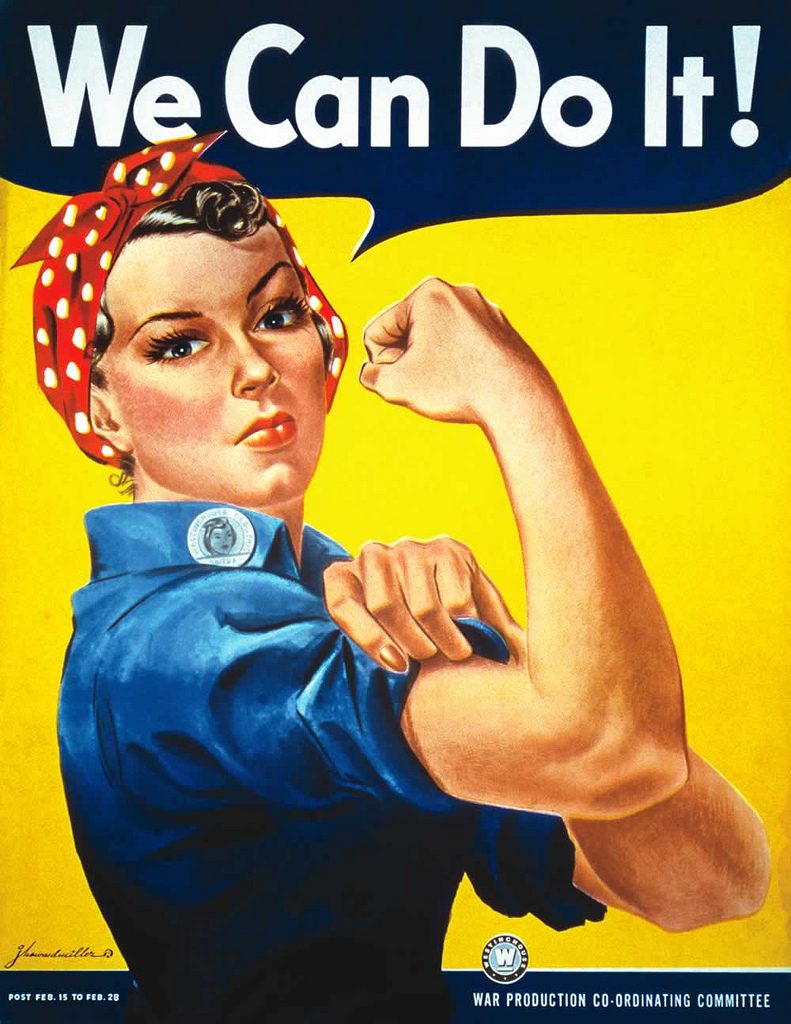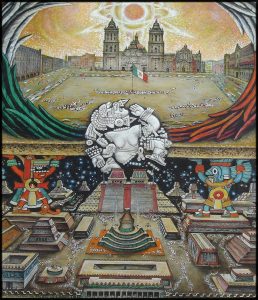From 1941 to 1945, during World War II, many woman were needed in the workplace because millions of men had joined the armed forces to fight in the European and the Pacific theaters of the war. In the Depression years just before this, women had been encouraged to stay at home, and let the men take the reduced number of manufacturing jobs available.1 With the onset of the war and the dramatically increased demand for manufactured wartime products, factories across the country opened their doors to women workers by the millions. In fact, there was a concerted effort to enlist women into the work force. In 1942, artist J. Howard Miller created the popular image of a woman named “Rosie the Riveter.” This poster was initially named, “We Can Do It!” and was made for the Westinghouse Electric and Manufacturing Company. Rosie was represented wearing makeup, a polka dot headband, and a rolled up sleeve shirt that portrayed strength and independence in women.2

Rosie the Riveter was a fictional character that many woman in the workforce identified with. The initial purpose of her image was to influence women to see themselves as capable of doing work previously thought to be men’s work. Her image combined beauty and strength, which is why many woman saw her as a role model. Even though Rosie the Riveter was a fictional character, her image was actually based on a photograph of a woman named Geraldine Doyle, who was a Michigan factory worker.3
There were some jobs that women took on that required training. Because of this, their wages were higher due to the fact that their jobs were more challenging and engaging compared to jobs that they may have had before. During the war, eighteen million women referred to themselves as being “Rosies.” Out of these eighteen million Rosies, six million had the opportunity to work for the first time. These women understood that the U.S. military and economy needed them; however, what motivated them to work was their own patriotism.4
In 1942, before Miller’s poster was created, Redd Evans and John Jacob Loeb wrote a song called, “Rosie the Riveter.” This hit song had lyrics that acknowledged and recognized the work that women did during the war:
All the day long whether rain or shine
She’s a part of the assembly line
She’s making history,
working for victory
Rosie the Riveter.
Keeps a sharp lookout for sabotage
Sitting up there on the fuselage
That little frail can do
more than a male will do
Rosie the Riveter.5
The song became associated with the existing images of Rosie the Riveter, which was a perfect blend of patriotism and beauty and strength in women.6
Unfortunately, after the war, the jobs and wages that Rosies had adapted to their lifestyles came to an end for the majority of them. Some went back to working “less challenging” jobs, and some became stay-at-home mothers. Because of this, birth rates increased, which led to the baby boom that lasted from 1946 through 1964. Even though many women went back to their previous lifestyles, they claimed to have left the workforce more confident and had more self-worth, knowing that they had proved to society that they were capable of doing men’s work.7
World War II changed the lifestyles of women significantly. Going from housewives to working in different industries allowed women to prove to society that this type of work was not just for men. There may have been no intention for women to prove themselves what they are capable of; however, women did leave their jobs after the war feeling better about themselves. Rosie the Riveter remains an iconic figure in American history, representing not only beauty in women, but also strength, courage, and confidence.
- Encyclopedia of Sex and Gender, 2007, s.v. “Rosie the Riveter,” by Susan L. Solomon. ↵
- America in the World, 1776 to the Present: A Supplement to the Dictionary of American History, 2016, s.v. “Rosie the Riveter,” by Nichola D. Gutgold. ↵
- Encyclopedia of Sex and Gender, 2007, s.v. “Rosie the Riveter,” by Susan L. Solomon. ↵
- Encyclopedia of Sex and Gender, 2007, s.v. “Rosie the Riveter,” by Susan L. Solomon. ↵
- Redd Evans and John Jacob Loeb, “Rosie the Riveter,” (New York: Paramount Music Corporation, 1942); The Four Vagabonds, “Rosie the Riveter,” recorded RCA Manufacturing Co., 1943. ↵
- America in the World, 1776 to the Present: A Supplement to the Dictionary of American History, 2016, s.v. “Rosie the Riveter,” by Nichola D. Gutgold. ↵
- Encyclopedia of Sex and Gender, 2007, s.v. “Rosie the Riveter,” by Susan L. Solomon. ↵



89 comments
Clarissa Bustamante
It is amazing how Rosie the Riveter and many women during World War ll had such an impact during this time period. Women were strong and courageous enough to be a part of the working force, as though they have never worked before. Reading this article was such an eye opener towards how women were so empowering in this time period. While the men were off at war the women were working, and with this image the patriotic women continued to give the country strength and hope.
Christine Sackey
As a female, I liked how this article proved that women are capable of multiple things and wearing multiple hats. Women saw the changes that were happening in the country at the time, and they decided to rise up to help this nation. I did not know that there was a song that the picture was associated with. The song was very catchy, and it really spoke about the difference that women were making. I thoroughly enjoyed this article.
Karina Nanez
How interesting that the iconic image of Rosie the Riveter had been created by The Four Vagabonds just a few years before the infamous poster. I never knew just how many women left their home lives to go work during World War II, the numbers are absolutely staggering. And to think they were forced out of their jobs so they could go back home to the domestic life they were expected to follow.
Alondra Aviles
Rosie the Riveter has been an iconic piece since the World War II, continuing to inspire many women to fell less excluded from jobs that are otherwise “meant for men”. This article greatly exemplifies the importance of women during this important era and honors the willingness women continue to have in the workforce. As a young female engaging in a challenging education, I consider Rosie the Riveter and the influence it created very influential. Although after the war many women backtracked into their “normal” jobs, it gave them a sense of accomplishment that created a domino effect into later generations. Slowly the stigma of women needing to become mothers and housewives will be abolished completely. This article accurately described the real power women can and are able to have.
Zeresh Haman
This article is truly amazing! I have always loved everything that Rosie the Riveter represents. I liked finding out that she was modeled after a woman named Geraldine Doyle, and that there is a song about it. I had no idea that even existed. It is unfortunate that many of the women that were inspired by this poster originally lost their jobs after the war, however, I think that it still brings a great deal of inspiration to women today. Many women are taking on more powerful positions and this will never cease to create that feeling of empowerment.
Priscilla Reyes
Rosie the Riveter is very well known, but her symbolism is greater. She portrays a strong woman and a woman of hope, too. Hope for the future of the country, but also putting that hope into practice. It is great that women who had never worked before had the courage to do so. I thought it was amazing that not only were they able to learn and grow, but they were also paid more than what usual salary was.
Mario De Leon
This was an inspiring read! I liked your use of multiple pictures and a video. I think everybody has seen this photo but I don’t think everybody knows the story behind it or the name of the person on it. I wonder why they choice to make the face of the poster a fictional person rather than finding someone to be the face of it.
Ana Gonzalez
I feel that the famous image of Rosie that you set as your featured image will live on forever. She represents all the American women who stood up to take up jobs in all types of industries during the war. You did a great job of explaining how this empowered women in america. I enjoyed watching the video you put in your article and the other pictures you set.
Thank you for your article. Hope you win any awards!
Mariana Govea
This picture is probably one of the most iconic signs in U.S. history all time. This portrait gave so much meaning to the women and citizens at the time of war. It gave many women a chance to work for themselves and do something because at that point in time, working women was unheard of. This article is a good read and gives great information on the origin of this portrait and its meaning and history. Great work!
Zander Barrera
Rosie truly is a woman of beauty and strength and still lives on today; WWII really did shape this world in many, MANY ways but in the case of American Women it was not only a call to metaphorical arms, but a game changer. woman would no longer be seen as lesser than men and even for the brief time were finally on equal footing in our society. you did an excellent job in telling Rosie’s story and I believe it was a good choice to include the video. it added that lively flare that defiantly complemented Rosie’s iconic image as well as the women of the time who did what needed to be done.